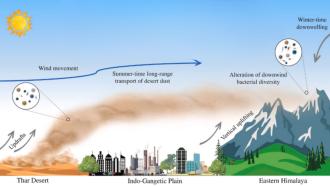![[Image by Pete Linforth from Pixabay] Fertilisers, livestock and biomass burning are spewing ammonia into the air across India](/sites/researchmatters/files/styles/large_800w_scale/public/pollution-48427061.jpg?itok=wZtcWyYb)
[Image by Pete Linforth from Pixabay]
Ammonia, a gas containing nitrogen molecules, is usually found in trace quantities in the atmosphere and plays a vital role in biochemical processes. When plants die, or animals excrete, the nitrogenous compounds in these residues get converted into ammonia. In the presence of specific soil bacteria, some ammonia gets converted into atmospheric nitrogen. However, large amounts of ammonia in the atmosphere is dangerous to plants. It damages the leaves, reduces essential nutrients, increases toxic substances in the plants, decreases their tolerance to drought and frost, and makes them more vulnerable to pests and disease-causing microorganisms. In the presence of moisture, ammonia can settle on our skin, killing the cells.
In India, studies on understanding the concentration of atmospheric ammonia have looked at the country as a whole, and for long periods. In a recent study, researchers from the Indian Institute of Technology Kharagpur (IIT Kharagpur) and the Indian Institute of Tropical Meteorology Pune (IITM Pune), and their international colleagues have broken this practice. They have studied the geographic and seasonal variations of atmospheric ammonia concentrations over India between 2008 and 2016. The study, published in the journal Science of The Total Environment, was partially funded by the Ministry of Earth Sciences, Government of India.
The researchers used data from a satellite-based instrument called the IASI (Infrared Atmospheric Sounding Interferometer), which measures the electromagnetic radiation emitted by the Earth’s surface. This radiation, which is in the infrared range of the electromagnetic spectrum, depends on the quantity of atmospheric ammonia. Researchers measure the radiation and calculate the amount of atmospheric ammonia using computer programs, which take in the radiation values recorded by satellites over a region of interest on the Earth’s surface. Each data point roughly encircles an area of 12 kilometres in diameter.
The Indo-Gangetic plains, covering the states of Uttar Pradesh and Bihar along the river Ganga, has the maximum atmospheric ammonia concentrations in the world, finds the study. It has the highest number of urea fertiliser plants. When the alkaline soil mixes with the nitrogenous fertilisers, it produces ammonia and releases it into the atmosphere. “Additionally, the livestock population in this region is quite high, which also contributes to higher ammonia emissions,” says Jayanarayan Kuttippurath, assistant professor at IIT Kharagpur and the lead author of the study.
“In India, agricultural sectors, including waste products of livestock, contribute 85–90% of ammonia emission. Hence, the Indo-Gangetic Plain is the hotspot of the ammonia emissions of the country,” agrees Sudhir Kumar Sharma, Principal Scientist at CSIR-National Physical Laboratory, New Delhi, who was not involved in the study.
The researchers studied how this emission over the region varied with the seasons and showed that it is maximum in the monsoon or Kharif season, between June and September. In these months, it is the largest over Punjab and Haryana. However, during the winter, the concentration significantly decreases across the country, including over the Indo-Gangetic plains. The researchers believe that the ammonia particles deposit onto the surface of the Earth during the cold months. Between March and May, it increases again due to activities surrounding the harvesting of crops, stubble burning, and sowing new crops.
In central India too, the ammonia concentrations varied as the Indo-Gangetic plains. “North-Eastern India shows comparatively high ammonia concentration during March and April,” says Jayanarayanan. Factors like biomass burning and forest fires, driven by the animal husbandry industry, contribute to these emissions. Comparatively, the southern peninsula has relatively low amounts of ammonia concentrations throughout the year. The researchers conclude the region’s choice of crops and cropping sequence play a significant role.
The study could not establish a significant trend in the ammonia variability over India during the study period. “The variability of ammonia primarily depends on meteorology and agricultural practices such as crop types and fertiliser consumption. We observed the highest annual ammonia concentration in 2010, which could be due to the highest annual total fertiliser consumption in that year,” says Jayanarayanan.
However, the researchers feel that the current study only indicates the causes, calling for more laboratories and field studies to make more precise predictions. “Ground-based observations are essential for correcting the satellite data and accurately estimate ammonia over the selected region of study,” says Sudhir, who has been doing such measurements. Recently, various research institutions across India have initiated a mega program, called the South Asian Nitrogen Hub, in association with the National Environment Research Council in the UK. “This program aims to estimate the emission of atmospheric ammonia from various sources over the Indian subcontinent,” he adds.
The researchers believe that regulating how much chemical fertiliser is used for crops may be an effective way to reduce the atmospheric emission of ammonia.
“Awareness programmes for farmers about the negative effect of overdose and overuse of fertilisers in the croplands needs to be conducted,” says Jayanarayanan.
Moreover, instead of applying raw manure to the land, a stable organic alternative will lower emissions. “Ammonia is already lost during the composting process if it is not properly executed,” he explains. Additionally, farmers can use urea inhibitors to prevent the conversion of urea to ammonia. While the possibilities are many, it requires significant effort by the authorities to take steps in the right direction. In the absence of policies to regulate ammonia, it is time for India to cement one.
This article has been run past the researchers, whose work is covered, to ensure accuracy.






